Vidyarthi Jain Dharm Shiksha
Added to library: September 2, 2025

Summary
Here's a comprehensive summary of the Jain text "Vidyarthi Jain Dharm Shiksha" by Shitalprasad, based on the provided content:
Title: Vidyarthi Jain Dharm Shiksha (Jain Dharma Education for Students) Author: Brahmachari Shitalprasad Publisher: Shitalprasad (Published by Mulchand Kisandas Kapadia, Malik, Di. Jain Pustakalay, Kapadia Bhuvan, Surat)
Purpose and Target Audience: The book is written in a question-and-answer format specifically to address the lack of religious knowledge among students, particularly Jain students in high schools and colleges. The author aims to make Jainism accessible and engaging for them, fostering an interest in the religion. It's also deemed beneficial for anyone seeking to understand Jainism and its similarities with other religions. The publisher emphasizes its need for promotion in schools, colleges, and boarding houses.
Key Themes and Content:
-
Introduction and Justification: The preface highlights the concern that students often become atheistic due to a lack of religious education. This book aims to fill that gap for Jain students by presenting Jain principles in an easy-to-understand manner.
-
Core Jain Principles (as covered in the table of contents and initial chapters):
- "Who am I?" (Main Ke?). The initial chapters delve into the fundamental question of self-identity, establishing the concept of the soul (Atma/Jiva) as distinct from the physical body. It explains that the body is made of inert matter (atoms), while the soul is the sentient, knowing entity. This is presented through a dialogue between a teacher and a student.
- Nature of the Soul: The soul is described as inherently pure, possessing infinite knowledge, peace, and bliss. It is the eternal, unchanging essence, while the physical body is its temporary dwelling.
- The Role of Karma: The book explains that the soul's current impure state and its experiences of happiness and sorrow are due to the accumulation of karma. Karma is described as subtle matter that binds to the soul, influencing its rebirths and circumstances.
- The Path to Liberation (Moksha): The ultimate goal is to purify the soul from karmic bondage and attain liberation, where the soul realizes its inherent pure, blissful, and omniscient nature.
- Nayas (Standpoints): The text introduces the crucial Jain concepts of Nishchaya Naya (Ultimate Truth/Essential Truth) and Vyavahara Naya (Conventional Truth/Practical Truth) to explain how seemingly contradictory statements can be reconciled within Jain philosophy.
- Tattvas (Principles): The book systematically explains the core Jain tattvas, generally starting with the seven or nine tattvas (Jiva, Ajiva, Asrava, Bandha, Samvara, Nirjara, Moksha, with Punhya and Pap sometimes added). It details the nature of the soul (Jiva), non-soul (Ajiva), influx of karma (Asrava), bondage of karma (Bandha), stoppage of karma influx (Samvara), shedding of karma (Nirjara), and liberation (Moksha).
- Karma Classification: It details the eight types of karma (Gnanavarniya, Darshanavarniya, Mohaniya, Antaraya, Ayushya, Nama, Gotra, Vedaniya) and their subcategories, explaining how they influence the soul.
- Deva and Purushartha (Destiny and Effort): The book discusses the interplay between destiny (karma's influence) and individual effort (purushartha) in shaping one's life and spiritual progress.
- Daily Conduct and Ethics: It outlines the conduct expected of Jain followers, including the vows (vratas) for monks and householders, the importance of equanimity, compassion, and detachment.
- Sects within Jainism: The book touches upon the differences between Digambara and Shvetambara traditions, particularly regarding attire and certain practices, but emphasizes that the core philosophical tenets and the path to liberation are the same. It advocates for understanding and unity despite outward differences.
- Comparison with Other Religions: A significant portion of the book (chapters 11-13) compares Jain principles with Buddhism, Hinduism (including Bhagavad Gita, Sankhya, Vedanta, Nyaya, Vaisheshika, Mimamsa), and briefly mentions Christianity, Theosophy, and Arya Samaj. It highlights similarities in ethical principles like non-violence, truthfulness, and the pursuit of inner peace, while also pointing out core doctrinal differences, especially regarding the nature of God and the soul's eternal state. The comparison with Buddhism is particularly detailed, suggesting a common root and emphasizing that many Buddhist practices and philosophies align with Jain teachings, albeit presented differently.
- Spiritual Practice: The book details the importance of meditation (Atmadhyana) and outlines methods for its practice, including posture, mantras, and focusing on the soul's qualities. It also discusses the role of devotion, idols (murti puja), and scriptural study as aids to spiritual development.
- The Thirteen Types of Conduct (Charitra): The text describes the progressive stages of spiritual practice for lay followers, leading towards monasticism.
- The Role of Gurus and Scriptures: The importance of learned spiritual guides and scriptures for understanding and practicing Jain Dharma is stressed.
-
Detailed Exploration of Tattvas: The book provides in-depth explanations of each tattva, including:
- Jiva (Soul): Its definition, characteristics (consciousness), types (based on senses, stages of development), and the concept of vitalities (pranas).
- Ajiva (Non-soul): Detailed descriptions of Pudgala (matter) with its properties and forms, Akash (space), Kala (time), Dharmastikaya (medium of motion), and Adharmastikaya (medium of rest).
- Asrava & Bandha (Karma Influx & Bondage): The causes (mind, speech, body, passions), types of karma, and the process of karmic bondage.
- Samvara & Nirjara (Karma Stoppage & Shedding): Methods to stop and shed karma, emphasizing virtue, austerity, meditation, and control over senses and passions.
- Moksha (Liberation): The state of liberation as the soul's natural pure state, free from all karmic bondage.
-
Support and Sponsorship: The book is dedicated to the "Nimitra" subscribers of 35 years and is sponsored by Seth Laxmichandji of Bhelsa, a prominent philanthropist. The preface lists various Jain books and their prices, indicating an effort to promote further study.
Overall Significance: "Vidyarthi Jain Dharm Shiksha" serves as an introductory yet comprehensive guide to Jainism for young students. It aims to provide a solid foundation in Jain philosophy, ethics, and practices, encouraging them to embrace their religious heritage. The book's comparative approach also positions Jainism within the broader religious and philosophical landscape, highlighting its unique aspects and universal ethical appeal.